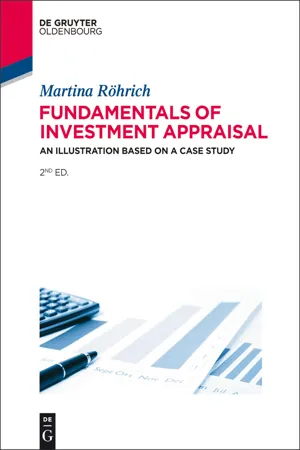Business
Net Present Value
Net Present Value (NPV) is a financial metric used to evaluate the profitability of an investment or project. It calculates the present value of all future cash flows generated by the investment, taking into account the time value of money. A positive NPV indicates that the investment is expected to generate more value than the initial cost, making it an attractive opportunity.
Written by Perlego with AI-assistance
Related key terms
9 Key excerpts on "Net Present Value"
- Daniel Adrian Doss, William H. Sumrall III, Don W. Jones(Authors)
- 2017(Publication Date)
- Routledge(Publisher)
Some initiatives may require periods that are longer than those that are considered within this text. When these situations occur, it is recommended that NPV calculations be performed through the use of software spreadsheets, proprietary software, or financial calculators. Also, within the context of collegiate finance courses, a tabular solution is also available to solve NPV problems involving a variety of periods. However, for the purposes of this text, the use of the basic formula is appropriate to demonstrate the basic concept of Net Present Value and to delineate the calculations through which NPV problems are solved. Future editions of this text, if any, are anticipated to contain the tabular solution methods of NPV problems.6.8 Chapter Comments and Summary
This chapter introduced the Net Present Value (NPV) method of capital budgeting. The methods of capital budgeting encompass perspectives of time, cash value, rate, and profitability potential. The NPV is indicative of a cash perspective regarding the rendering of capital budgeting decisions. Further, the NPV method incorporates the time value of money within its primary construct. Derivation of the NPV method can occur through algebraic manipulation of the current monetary value formula given in Chapter 4 .The NPV method involves a consideration of the anticipated cash flows of a capital investment through time. These anticipated future values are discounted to determine their current monetary equivalencies. Conceptually, the NPV is the sum of the present monetary value of the anticipated future cash flows of a potential capital investment excluding the costs of investment. Therefore, the NPV method provides a cash-based perspective regarding capital budgeting initiatives. The NPV may be used as a solitary method of capital budgeting or may be used in conjunction with any (or all) of the capital budgeting methods described within this text. The NPV method may be used to examine single capital initiatives or multiple capital initiatives. Further, this method may be used with or without the constraints imposed by mutual exclusion conditions.- eBook - ePub
- Brümmer LM, Hall JH, Du Toit E(Authors)
- 2017(Publication Date)
- Van Schaik Publishers(Publisher)
We all know that, provided income exceeds cost, a profit will be shown. If income is lower than cost, a loss will result. The criterion here, therefore, is whether the total present value of all future cash inflows will be greater than the initial cost of the investment. If the total present value of a series of cash inflows is greater than the initial cost of the investment project, a profit will be shown and the investment should be accepted as a feasible proposition. If the total present value of these inflows is less than the initial cost, a loss will be sustained and the project should be rejected.The term “net” means that a difference must be found. In terms of the NPV concept, the difference that we must find is the one between the total present value of a series of future cash inflows and the cost of the initial investment. If the net amount, more commonly and simply referred to as the NPV, has a positive value, the investment may be accepted. If the NPV is a negative figure, the project should be rejected.An explanation of cash flows
Before discussing an example of the NPV, we should gain a fuller understanding of the meaning of cash inflows and outflows. A cash inflow, as the name implies, is cash flowing into the organisation. Similarly, a cash outflow is cash flowing out of it. - eBook - ePub
- Rob Dransfield(Author)
- 2013(Publication Date)
- Routledge(Publisher)
Compound interest – this arises when interest is added to the principal (initial sum borrowed or lent) so that from that moment on, the interest that has been added also earns interest. Adding interest to the principal is termed ‘compounding’.Calculating Net Present Value Key TermNet Present Value (NPV) – the total of all cash flows restated in today’s money terms.Net Present Value is based on actual cash flows. These will include inflows:- Sales revenues, phased according to when they are actually received.
- Sales proceeds from the disposal of fixed assets at the conclusion of a project.
- The release of amounts invested in stocks at the end of a project.
- Government grants.
And outflows:- Investment in fixed assets.
- Creation of a working stock balance.
- Operating costs, including material, labour and expenses.
The easiest way of finding a discount factor is to look it up in an NPV table (see Table 17.3 ). This can save a lot of time and effort (discount tables can be accessed on the Internet – simply carry out a search for ‘discount tables’). For example, Table 17.3 shows that cash in four years’ time discounted at 10 per cent should be multiplied by a factor of 0.6830.Calculating the discount factorTable 17.3 A simple discount table for different rates of interest and time periodsWhen calculating NPV it is also possible to calculate the discount factor without having to rely on NPV tables (however, in the days of rapid calculation and access to computerized tables there would be little point in doing so). The calculation is shown below:Where: r = Discount rate n = Number of years For example, cash received in four years’ time to be discounted at 10 per cent is calculated as follows:We can now illustrate how discount factors are used to calculate NPV in Table 17.4 - eBook - ePub
- P. Cassimatis(Author)
- 2013(Publication Date)
- Routledge(Publisher)
For example, a machine can be purchased today for $100,000. It has a useful life of 5 years and its cash flow is forecasted to be $30,000 per year. If the required rate of return is 10%, we haveThe required rate of return is the rate the firm can obtain from comparable investment alternatives. It is also known as the discount rate, the cost of capital, the hurdle rate, or the minimum acceptable rate of return.The advantages of the Net Present Value method are that it takes into account the time value of money, and regardless of the pattern of cash flows, a single Net Present Value is easily calculated. Consider, for example, the two investments shown below:Project A involves an initial investment of $2,500 and expected cash flows for 3 years. Project B requires the same initial investment, an additional cash outlay of $1,000 in the first year, and positive cash flows in the second and third year. Suppose the required rate of return is 10%. Then the NPVs of the projects are:Since the NPV of A is the larger of the two, project A is the better investment.When the cost of a project is spread over a number of years, the Net Present Value of the investment is obtained as follows:Suppose, for example, a new assembly line is installed in a manufacturing plant and it takes one year to complete construction and another year to install the equipment. Cash flows, in thousand dollars, begin in the second year as shown in Figure 4.1 .The Net Present Value of this project is computed as follows: Figure 4.1 Cash flows of project.4.2 Internal rate of return
Perhaps the method most widely used by engineers and business managers in evaluating capital projects is the internal rate of return method, commonly known as IRR. While this method has been criticized as having serious deficiencies, its major advantage is that it expresses the profitability of a capital investment in percentage terms, a measure that is easily understood by experts and laymen alike. The internal rate of return for an investment is the rate of return (i.e. interest rate) that makes the present value of the cash flows equal to the cost of the investment. Mathematically, it is calculated from - eBook - ePub
Corporate Finance
Theory and Practice
- Pierre Vernimmen, Pascal Quiry, Yann Le Fur(Authors)
- 2022(Publication Date)
- Wiley(Publisher)
discounting factor, which is the inverse of the coefficient of capitalisation. The present value of €1,800,000 in 10 years at a 33.5% rate is €100,000.More generally:which is the exact opposite of the capitalisation formula.1 / (1 + r)nis the discounting factor, which depreciates Vnand converts it into a present value V0 . It is most often below 1, as discounting rates are generally positive.Section 16.3 PRESENT VALUE AND Net Present Value OF A FINANCIAL SECURITY
Owning a financial security such as a stock or a bond means owning the right to receive cash flows (dividend, interest, reimbursement, etc.) according to the specific terms of the security.1/ FROM THE PRESENT VALUE OF A SECURITY …
The present value (PV) of a security is the sum of its discounted cash flows, i.e.:where Fnare the cash flows generated by the security, r is the applied discounting rate and n is the number of years for which the security is discounted.All securities also have a market value, particularly on the secondary market. Market value is the price at which a security can be bought or sold.Net Present Value (NPV) is the difference between present value and market value (V0):If the Net Present Value of a security is greater than its market value, then it will be worth more in the future than the market has presently valued it at. Therefore, you will probably want to invest in it, i.e. to invest in the upside potential of its value.If, however, the security's present value is below its market value, then you should sell it at once (as its Net Present Value is negative), for its market value is sure to diminish.2/ … TO ITS FAIR VALUE
If an imbalance occurs between a security's market value and its present value, then efficient markets will seek to re-establish balance and reduce Net Present Value to zero. Investors acting on efficient markets seek out investments offering positive Net Present Value, in order to realise that value. When they do so, they push Net Present Value towards zero, ultimately arriving at the fair value of the security. - eBook - ePub
- Keith Ward(Author)
- 2013(Publication Date)
- Routledge(Publisher)
However, money has a time value and if we are to make sensible decisions we need to incorporate the real value of future cash flows into our evaluation criteria. We can achieve this by applying discount rates to all future cash flows so that we bring them back to their equivalent present value, which makes all the project cash flows directly comparable. The most common way of doing this is to select a discount rate for the company and to apply this to all the cash flows of the project. A positive Net Present Value indicates that the financial return from the investment is acceptable, but the opportunity costs evaluation against other potential investments must still be done. This requires comparison of what benefits could be achieved by investing in a different mix of projects and where there are constraints on the total amount of capital which can be invested, this comparison is very important. In such a situation of capital rationing, the profitability index can be used to compare relative investment returns between projects; this is done by dividing the present value of the net inflows by the value of the initial investment.Table 7.25 Comparison of internal rate of return (IRR) and accounting return on investmentSeveral major investment evaluation techniques are used by companies: 1 payback period; 2 discounted payback period; 3 Discounted cash flow (a) Net Present Value (NPV) (b) internal rate of return (IRR); 4 Accounting return on investment (ARR).These provide different views of any project and no single criterion can be regarded as giving the answer, so many companies use a combination of techniques and adjust the results to allow for the relative risk of the investment being examined.AppendixNew car example using financial statements comparison ResuméOur sales and marketing director’s car cost £21 000 and is assumed to have a £6000 residual value at the end of three years. A fuel efficiency device becomes available for £4500 with projected savings of £2000 per year. - eBook - ePub
- Alan Parkinson(Author)
- 2012(Publication Date)
- Routledge(Publisher)
Table 7.2 can help to solve a dilemma. If a management team used an undiscounted cash flow assessment, both investments return the same net inflow of £170,000. The same applies to an undiscounted payback assessment with both investments paying back in 2.75 years. When the time value for money is considered however, a discounted NPV cash flow assessment, Investment B is favoured, returning £60,490 as opposed to £58,490 for A. On a discounted payback assessment however, Investment A pays back in 3.6 years, whereas B takes 4.4 years. Clearly, the dilemma facing the management team here is great. It is compounded by the fact that, on an IRR basis, A has a rate of 12.2% and B 11.4%.In ranking situations like this, where funds may be inadequate to finance all potentially profitable projects, or where a choice needs to be made between a number of contenders, a further method of evaluation called the profitability index could be used. This is based on the same data as the NPV method, in that a target rate of return has to be established and the NPV calculated. What then happens is that the present value of an investment’s inflows is related to the present value of its outflows in the form of a ratio, this being:Under this criterion, the two investments would be ranked as follows: The profitability index shows us the Net Present Value of each £ invested. Under this criterion, investment B shows up better than A.It is quite common for the profitability index to be misused. This is because the term cash outflow is often interpreted as relating solely to the initial outlay at time 0. It is not unusual for net outflows to be encountered in subsequent years and these must be incorporated as outflows within the index calculation.In summary, what we can say is that the common aim of discounted cash flow techniques is to translate a projected stream of cash flows into one single index number that is then capable of comparison with other index numbers.If the projected net cash flows are discounted back to present values at a predetermined target rate of return, then the sum of these plus or minus discounted values will be the Net Present Value of the project in absolute terms. If, on the other hand, they are discounted at a rate which results in the sum of the present values of the projected inflows equating exactly with the sum of the present values of the projected outflows, then the Net Present Value will be nil and the rate that needs to be applied in order to achieve this balance is the internal rate of return of the project. This is consequently a relative - Ivan E Brick(Author)
- 2017(Publication Date)
- WSPC(Publisher)
CHAPTER 5
CAPITAL BUDGETING AND COMPANY VALUATION
What is Capital Budgeting?
Capital budgeting is the process that managers use to determine the selection of projects in which the firm should invest in order to maximize the shareholder wealth. In this chapter, we will teach you the basic finance tools used for capital budgeting. We will show you how these tools enable managers to evaluate strategies for expansion, to select equipment for modernization and for increasing manufacturing capacity, and to erect barriers to entry. We will also show how these basic tools can be used to evaluate a firm’s asset or stock price. These tools use time value techniques we illustrated in the Time Value chapter.Some basic financial tools for capital budgeting
The job of the corporation is to take the money entrusted to it by the shareholders and invest it. The stock price will increase only if the investment yields a return greater than what the shareholders can do on their own. How do we differentiate between the good and bad projects? Finance suggests two approaches and both of these approaches rely heavily on the time value of money. The first approach is the Net Present Value (NPV) and the second approach is the Internal Rate of Return (IRR). Both approaches require the manager to forecast future cash flows and to determine how much it costs the firm to raise money.What is Net Present Value?
Net Present Value is defined as the time value of the cash flows generated by a capital expenditure less the capital expenditure. More formally:where CFT is expected cash flow of the project in period T, R is the cost of capital (of funds or the interest cost of raising money from investors), and I is the capital expenditure. The NPV rule states that firms should accept projects with NPV > 0 and reject the project if NPV < 0.∑ is the Greek letter sigma. In mathematics it represents summation. The subscript letter t in CFt is a time index. The T = 1 below the sigma and N above the sigma implies that you are summing the present value of the cash flows from period 1 to n- eBook - ePub
- Martina Röhrich(Author)
- 2014(Publication Date)
- De Gruyter Oldenbourg(Publisher)
0 . The Net Present Value approach should be preferred to the internal rate of return because of its reinvestment assumption. Despite the superiority of the Net Present Value approach other criteria are not completely irrelevant and useless. They may be used as supplementary measures to facilitate decision-making.- – The following were the main points covered:
- – A pre-condition for a useful application of discounting investment appraisal techniques is the possibility to identify all relevant cash flows.
- – Problems arise if interdependencies with the company’s environment exist, e. g. if it is not possible to isolate the outcomes of the investment.
- – So far, we have not considered qualitative investment assessment criteria.
- – Up to this point all techniques presented are based on certain estimates about the input data.
- – In the following chapters we introduce uncertainty as well as qualitative investment assessment criteria. Furthermore we integrate the effects of taxation, inflation and financing the investment if the borrowing and the lending interest rates are not equal. The simplifying assumptions under which the discounting methods of investment appraisal were introduced are put aside step by step.
3.8 Exercises with Answers
3.8.1 Exercises
Exercise 3-1 Basics of the discounting methods of investment appraisal- a) At the beginning of year 1 you can invest € 5,000. If the interest rate is 8 % per annum, how much will you get at the end of year 6?
- b) Suppose in three years you would need the sum of € 250,000 to buy land. Money could be left on deposit at an interest rate of 7 %. How much do you have to invest today?
Learn about this page
Index pages curate the most relevant extracts from our library of academic textbooks. They’ve been created using an in-house natural language model (NLM), each adding context and meaning to key research topics.








